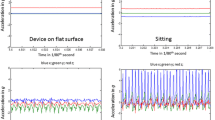Abstract
Physical inactivity and sedentary behaviors are on the rise worldwide and contribute to the current overweight and obesity scourge. The loss of healthy life style benchmarks and the lack of the need to move make it necessary to provide feedback about physical and sedentary activities in order to promote active ways of life. The aim of this study was to develop a specific function adapted to overweight and obese people to identify four physical activity (PA) categories and to estimate the associated total energy expenditure (TEE). This function used accelerometry data collected from a smartphone to evaluate activity intensity and length, and TEE. The performance of the proposed function was estimated according to two references (Armband® and FitmatePro®) under controlled conditions (CC) for a 1.5-h scenario, and to the Armband® device in free-living conditions (FLC) over a 12-h monitoring period. The experiments were carried out with overweight and obese volunteers: 13 in CC and 27 in FLC. The evaluation differences in time spent in each category were lower than 7% in CC and 6% in FLC, in comparison to the Armband® and FitmatePro® references. The TEE mean gap in absolute value between the function and the two references was 9.3% and 11.5% in CC, and 8.5% according to Armband® in FLC.





Similar content being viewed by others
References
Lee, I.M., et al., Effect of physical inactivity on major non-communicable diseases worldwide: An analysis of burden of disease and life expectancy. Lancet, 2012. doi:10.1016/S0140-6736(12)61031-9.
Hallal, P.C., et al., Global physical activity levels: Surveillance progress, pitfalls, and prospects. Lancet., 2012. doi:10.1016/S0140-6736(12)60646-1.
Saidj, M., et al., Descriptive study of sedentary behaviours in 35,444 French working adults: Cross-sectional findings from the ACTI-cites study. BMC Public Health, 2015. doi:10.1186/s12889-015-1711-8.
Ekelund, U., et al., Does physical activity attenuate, or even eliminate, the detrimental association of sitting time with mortality? A harmonised meta-analysis of data from more than 1 million men and women. Lancet, 2016. doi:10.1016/S0140-6736(16)30370-1.
Chen, K.Y., and Bassett, D.R., The technology of accelerometry-based activity monitors: Current and future. Med Sci Sports Exerc., 2005. doi:10.1249/01.mss.0000185571.49104.82.
Ruiz-Casado, A., et al., Validity of the physical activity questionnaires IPAQ-SF and GPAQ for cancer survivors: Insights from a Spanish cohort. Int J Sports Med., 2016. doi:10.1055/s-0042-103967.
Prince, S.A., et al., A comparison of direct versus self-report measures for assessing physical activity in adults: A systematic review. Int J Behav Nutr Phys Act., 2008. doi:10.1186/1479-5868-5-56.
Guidoux, R., et al., A smartphone-driven methodology for estimating physical activities and energy expenditure in free-living conditions. J Biomed Inform., 2014. doi:10.1016/j.jbi.2014.07.009.
Duclos, M., et al., Use of smartphone accelerometers and signal energy for estimating energy expenditure in daily-living conditions. Curr Biotech., 2015. doi:10.2174/2211550104666150227220930.
Guidoux, R., et al., The eMouveRecherche application competes with research devices to evaluate energy expenditure, physical activity and still time in free-living conditions. J. Biomed. Inform., 2017. (Revision).
St-Onge, M., Mignault, D., Allison, D.B., and Rabasa-Lhoret, R., Evaluation of a portable device to measure daily energy expenditure in free-living adults. Am J Clin Nutr. 85(3):742–749, 2007.
Rousset, S., et al., Comparison of total energy expenditure assessed by two devices in controlled and free-living conditions. Eur J Sport Sci., 2015. doi:10.1080/17461391.2014.949309.
Paris, et al., Evaluation of physical activity intensities and energy expenditure in overweight and obese adults. J Sports Exerc Med. 2(3):1–6, 2016.
Garcia-Valverde, T., Munoz, A., Arcas, F., Bueno-Crespo, A., and Caballero, A., Heart health risk assessment system: A nonintrusive proposal using ontologies and expert rules. BioMed Res Int., 2014. doi:10.1155/2014/959645.
Ainsworth, B.E., et al., Compendium of physical activities: A second update of codes and MET values. Med Sci Sports Exer., 2011. doi:10.1249/MSS.0b013e31821ece12.
Norton, K., Norton, L., and Sadgrove, D., Position statement on physical and exercise intensity terminology. J Sci Med Sport. doi:10.1016/j.jsams.2009.09.008.
Mifflin, M.D., et al., A new predictive equation for resting energy expenditure in healthy individuals. Am J Clin Nutr. 51(2):241–247, 1990.
Bland, J.M., and Altman, D.G., Statistical methods for assessing agreement between two methods of clinical measurement. Lancet. 1(8476):307–331, 1986.
Judice, P.B., Santos, D.A., Hamilton, M.T., Sardinha, L.B., and Silva, A.M., Validity of GT3X and Actiheart to estimate sedentary time and breaks using ActivPAL as the reference in free-living conditions. Gait Posture., 2015. doi:10.1016/j.gaitpost.2015.03.326.
Kozey-Keadle, S., et al., Validation of wearable monitors for assessing sedentary behavior. Med Sci Sports Exerc., 2011. doi:10.1249/MSS.0b013e31820ce174.
Oliver, M., et al., Associations between breaks in sedentary time and body size in Pacific mothers and their children: Findings from the Pacific Islands families study. J Phys Act Health. 10(8):1166–1174, 2013.
Thorp, A.A., et al., Alternating sitting and standing increases the workplace energy expenditure of overweight adults. J Phys Act Health., 2016. doi:10.1123/jpah.2014-0420.
Wen, D., et al., Evaluating the consistency of current mainstream wearable devices in health monitoring: A comparison under free-living conditions. J Med Internet Res., 2017. doi:10.2196/jmir.6874.
Wang, A., et al., A comparative study on human activity recognition using inertial sensors in a smartphone. IEEE Sensors J. 16(11):4566–4578, 2016.
Pataky, Z., et al., Effects of obesity on functional capacity. Obesity., 2014. doi:10.1002/oby.20514.
Acknowledgements
Special thanks to the volunteers for their participation in this study and to Gail Wagman for correcting the English.
Author information
Authors and Affiliations
Corresponding author
Ethics declarations
Funding
This study was funded by almerys (grant: research collaboration n° 101,923–581).
Conflict of Interest
INRA has received a research grant from almerys. The authors declare that they have no conflict of interest.
Ethical Approval
All procedures performed in studies involving human participants were in accordance with the ethical standards of the national research committee and with the 1964 Helsinki declaration and its later amendments or comparable ethical standards.
Additional information
This article is part of the Topical Collection on Mobile & Wireless Health
Rights and permissions
About this article
Cite this article
Rousset, S., Guidoux, R., Paris, L. et al. A Novel Smartphone Accelerometer Application for Low-Intensity Activity and Energy Expenditure Estimations in Overweight and Obese Adults. J Med Syst 41, 117 (2017). https://doi.org/10.1007/s10916-017-0763-y
Received:
Accepted:
Published:
DOI: https://doi.org/10.1007/s10916-017-0763-y




